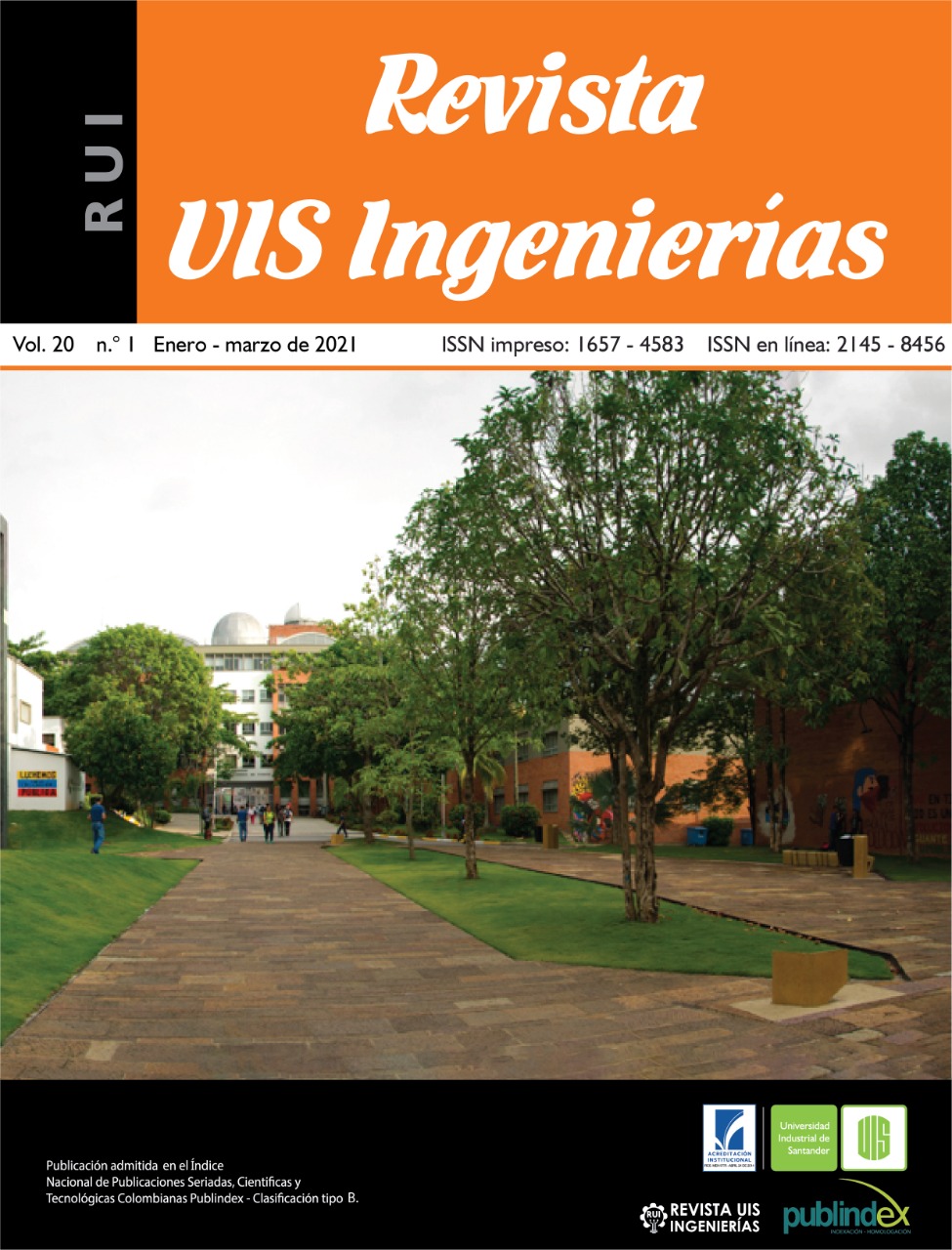Mechanical behavior of cortical bone tissue under cyclic tensile and compressive conditions
Published 2020-11-03
Keywords
- mechanical behavior,
- cyclic compression,
- damage,
- strain,
- plastic deformation energy
- elastic modulus,
- post-yield,
- cortical tissue,
- cyclic tension,
- experimental testing ...More
How to Cite
Copyright (c) 2020 Revista UIS Ingenierías

This work is licensed under a Creative Commons Attribution-NoDerivatives 4.0 International License.
Abstract
This research aims to experimentally study the mechanical response of cortical bone tissue under cyclic tensile and cyclic compression loading conditions. Thus, experimental specimens were built from bovine femurs which were subjected to low cycle stresses at post-yield at different loading rates. The results reveal that the speed of degradation of the elastic modulus is inversely proportional to the deformation rate for tension cases and directly proportional to the deformation rate for compression ones. Plastic strains start at total strain levels above 0,35% and 1,09% for the tension and compression loaded samples, respectively. Important mathematical expressions were obtained which help to estimate with good approximation the instantaneous elastic modulus, the total applied deformation, and the total plastic deformation energy.
Downloads
References
[2] C. A. Pattin, W. E. Caler, D. R. Carter, “Cyclic mechanical property degradation during fatigue loading of cortical bone”, Journal of Biomechanics, vol. 29, no. 1, pp. 69-79, 1996, doi: 10.1016/0021-9290(94)00156-1
[3] D. B. Burr, M. R. Forwood, D. P. Fyhrie, R. B. Martin, M. B. Schaffler, C. H. Turner, “Bone microdamageand skeletal fragility in osteoporotic and stress fractures”, Journal of Bone and Mineral Research, vol. 12, no. 1, pp. 6-15, 1997, doi: 10.1359/jbmr.1997.12.1.6
[4] M. J. Mirzaali, F. Libonati, D. Ferrario, L. Rinaudo, C. Messina, F. M. Ulivieri, B. M. Cesana, M. Strano, L. Vergani, “Determinants of bone damage: An ex-vivo study on porcine vertebrae”, PLoS One, vol. 13, no. 8, 2018, doi: 10.1371/journal.pone.0202210
[5] M. A. R. Freeman, R. C. Todd, C. J. Pirie, “The role of fatigue in the pathogenesis of senile femoral neck fractures”, The Journal of Bone and Joint Surgery, vol. 56B, no. 4, pp. 698-702, 1974, doi: 10.1302/0301-620X.56B4.698
[6] M. B. Schaffler, K. Choi, C. Milgrom, “Aging and matrix micro damage accumulation in human compact bone”, Bone, vol. 17, no. 6, pp. 521-525, 1995, doi: 10.1016/8756-3282(95)00370-3
[7] D. B. Burr, R. B. Martin, M. B. Schaffler, E. L. Radin, “Bone remodeling in response to in vivo fatigue micro damage”, Journal of Biomechanics, vol. 18, no. 3, pp. 189-200, 1985, doi: 10.1016/0021-9290(85)90204-0
[8] J. Seto, H. S. Gupta, P. Zaslansky, H. D. Wagner, P. Fratzl, “Tough lessons from bone: Extreme mechanical anisotropy at the meso scale”, Advanced Functional Materials, vol. 18, no. 13, pp. 1905-1911, 2008, doi: 10.1002/adfm.200800214
[9] W. J. Parnell, Q. Grimal, “The influence of meso scale porosity on cortical bone anisotropy. Investigations via asymptotic homogenization”, Journal of the Royal Society Interface, vol. 6, no. 30, pp. 97-109, 2009, doi: 10.1098/rsif.2008.0255
[10] S. J. Kirkpatrick, B. W. Brooks, “Micromechanical behavior of cortical bone as inferred from laser speckle data”, Journal of Biomedical Materials Research, vol. 39, no. 3, pp. 373-379, 1998, doi: 10.1002/(SICI)1097-4636(19980305)39:3<373::AID-JBM5>3.0.CO;2-G
[11] S. I. Ranganathan, D. M. Yoon, A. M. Henslee, M. B. Nair, C. Smid, F. K. Kasper, E. Tasciotti, A. G. Mikos, P. Decuzzi, M. Ferrari, “Shaping the micromechanical behavior of multi-phase composites for bone tissue engineering”, ActaBiomaterialia, vol. 6, no. 9, pp. 3448-3456, 2010, doi: 10.1016/j.actbio.2010.03.029
[12] D. B. Burr, C. H. Turner, P. Naick, M. R. Forwood, W. Ambrosius, M. S. Hasan, R. Pidaparti, “Does microdamage accumulation affect the mechanical properties of bone?”, Journal of Biomechanics, vol. 31, no. 4, pp. 337-345, 1998, doi: 10.1016/S0021-9290(98)00016-5
[13] G. C. Reilly, J. D. Currey, “The effects of damage and microcracking on the impact strength of bone”, Journal of Biomechanics, vol. 33, no. 3, pp. 337-343, 2000, doi: 10.1016/S0021-9290(99)00167-0
[14] K. J. Jepsen, D. T. Davy, “Comparison of damage accumulation measures in human cortical bone”, Journal of Biomechanics, vol. 30, no. 9, pp. 891-894, 1997, doi: 10.1016/S0021-9290(97)00036-5
[15] D. F. Knott, K. J. Jepsen, D. T. Davy, “Age related changes in tensile damage accumulation behavior of human cortical bone”, en Proc. 46th Annu. Meeting Orthopaedic Research Society, Orlando, 2000, pp. 10.
[16] J. Y. Rho, L. Kuhn-Spearing, P. Zioupos, “Mechanical properties and the hierarchical structure of bone”, Medical Engineering & Physics, vol. 20, no. 2, pp. 92-102, 1998, doi: 10.1016/S1350-4533(98)00007-1
[17] M. A. Meyers, P.-Y. Chen, A. Y. -M. Lin, Y. Seki, “Biological materials: Structure and mechanical properties”, Progress in Materials Science, vol. 53, no. 1, pp. 201-206, 2008, doi: 10.1016/j.pmatsci.2007.05.002
[18] C. H. Turner, D. B. Burr, “Basic biomechanical measurements of bone: A tutorial”, Bone, vol. 14, no. 4, pp. 595-608, 1993, doi: 10.1016/8756-3282(93)90081-K
[19] T. S. Keller, M. A. K. Liebschner, “Tensile and compression testing of bone”, en Mechanical Testing of Bone and the Bone–implant Interface, Boca Raton: CRC Press, 1999, pp. 175-206, doi: 10.1201/9781420073560
[20] R. D.Crowninshield, M. H. Pope, “The response of compact bone in tension at various strain rates”, Annals of Biomedical Engineering, vol. 2, pp. 217-225, 1974, doi: 10.1007/BF02368492
[21] X. Wang, J. S. Nyman, X. Dong, H. Leng, M. Reyes, “Fundamental biomechanics in bone tissue engineering”, Synthesis Lecture on Tissue Engineering, vol. 2, no. 1, pp. 1-225, doi: 10.2200/S00246ED1V01Y200912TIS004
[22] B. Varghese, D. Short, R. Penmetsa, T. Goswami, T. Hangartner, “Computed-tomography-based finite-element models of long bones can accurately capture strain response to bending and torsion”, Journal of Biomechanics, vol. 44, no. 7, pp. 1374-1379, 2011, doi: 10.1016/j.jbiomech.2010.12.028
[23] J. Lemaitre, R. Desmorat, Engineering Damage Mechanics. New York, NY, USA: Springer-Verlag Berlin Heidelberg, 2005.
[24] D. R. Carter, W. C. Hayes, “The compressive behavior of bone as a two-phase porous structure”, Journal of Bone and Joint Surgery, vol. 59, no. 7, pp. 954-962, 1977.
[25] P. Zioupos, J. D. Currey, A. J. Sedman, “An examination of the micromechanics of failure of bone and antler by acoustic emission tests and laser scanning con focal microscopy”. Medical Engineering and Physics, vol. 16, no. 3, pp. 203-212, 1994, doi: 10.1016/1350-4533(94)90039-6

